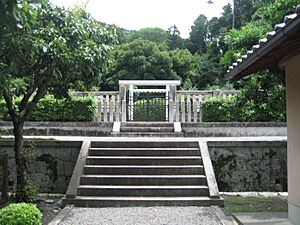Emperor Reizei facts for kids
Quick facts for kids Emperor Reizei冷泉天皇 |
|||||
|---|---|---|---|---|---|
| Emperor of Japan | |||||
| Reign | July 5, 967 – September 27, 969 | ||||
| Coronation | November 15, 967 | ||||
| Predecessor | Murakami | ||||
| Successor | En'yū | ||||
| Born | June 12, 949 Heian Kyō (Kyōto) |
||||
| Died | November 21, 1011 (aged 62) Heian Kyō (Kyōto) |
||||
| Burial | Sakuramoto no misasagi (櫻本陵) (Kyoto) | ||||
| Spouse | Masako | ||||
| Issue |
|
||||
|
|||||
| House | Yamato | ||||
| Father | Emperor Murakami | ||||
| Mother | Fujiwara no Anshi | ||||
Emperor Reizei (冷泉天皇, Reizei-tennō, June 12, 950 – November 21, 1011) was the 63rd emperor of Japan. He followed the traditional order of succession.
Emperor Reizei's time as ruler lasted from 967 to 969. After this, he decided to step down and live in retirement.
Contents
Emperor Reizei's Early Life
Before he became emperor, his personal name was Norihira-shinnō (憲平親王). This was his imina, a private name used only by close family.
Norihira-shinnō was the second son of Emperor Murakami. His mother, Empress Yasuko, was the daughter of a powerful minister named Fujiwara no Morosuke. Even though he was the second son, he was chosen to be the crown prince soon after he was born. This decision meant he replaced the Emperor's first-born son. It is believed that Morosuke and his brother Fujiwara no Saneyori used their influence at court to make this happen.
The family of the first-born son was very upset. People at the time believed that Norihira-shinnō's health challenges were caused by the unhappy spirit of the person who lost the chance to be emperor. Because of these health issues, Fujiwara no Saneyori acted as a regent. A regent is someone who rules for the emperor when the emperor is too young or unable to rule himself. Saneyori was the regent for Reizei's entire short reign.
The Reizei Genji Clan
For a very long time, there have been four important noble families in Japan. They are known as the Gempeitōkitsu. One of these families is the Minamoto clan (源氏), also called the Genji. A special branch of this family, called the Reizei Genji (冷泉源氏), are descendants of Emperor Reizei.
Key Events During Reizei's Reign
There were some concerns about Norihira-shinnō's health, which made his path to becoming emperor a bit difficult.
In 967, his father, Emperor Murakami, passed away. Reizei then became emperor when he was eighteen years old.
- July 5, 967 (Kōhō 4, 25th day of the 5th month): Emperor Murakami died. His second son, Norihira-shinnō, became the new emperor. This is known as his "accession" to the throne.
- 969 (Anna 2): Emperor Reizei decided to step down from the throne. This is called "abdication." He then took the special title of Reizei-in Jōkō. His time as emperor lasted only two years. He lived for another 44 years after he retired.
- November 21, 1011 (Kankō 8, 24th day of the 10th month): The retired Emperor Reizei-in Jōkō passed away at the age of 62.
The exact place where Emperor Reizei is buried is known. This emperor is honored at a special memorial Shinto shrine in Kyoto. This type of burial place is called a misasagi.
The Imperial Household Agency is the official group that looks after the emperor's family and their historical sites. They have named Reizei's burial place Sakuramoto no misasagi.
Important Court Officials (Kugyō)
The Kugyō (公卿) was a group of the most powerful men in the Emperor's court in Japan before the Meiji era.
This special group usually had only three or four men at a time. These men came from important families and had a lot of experience. They reached the highest levels of their careers. During Reizei's reign, some of the top officials included:
- Kampaku, Ōno-no-miya Fujiwara no Saneyori (藤原実頼), who lived from 900 to 970.
- Daijō-daijin, Fujiwara Saneyori.
- Sadaijin, Minamoto no Takaakira (源高明). He was removed from his position in 969.
- Sadaijin, Fujiwara Morotada (藤原師尹).
- Udaijin, Fujiwara Morotada (藤原師尹), who lived from 920 to 969.
- Naidaijin (this position was not filled during his reign).
- Dainagon, Fujiwara no Arihira (藤原在衡).
- Dainagon, Minamoto no Kaneakira (源兼明).
- Dainagon, Fujiwara no Koretada (藤原伊尹).
Time Periods During Reizei's Reign
The years of Emperor Reizei's reign are also known by different Japanese era names (年号, nengō). These are special names for periods of time.
Emperor Reizei's Family
Emperor Reizei had several consorts and children.
Empress (Chūgū): Imperial Princess Masako (昌子内親王). She later became known as Kanon'in taigō (観音院太后) and was the daughter of Emperor Suzaku.
- Adopted Son: Imperial Prince Nagahira (永平親王; 965–988)
Consort (Nyōgo): Fujiwara no Kaishi/Chikako (藤原懐子, 945–975). She was the daughter of Fujiwara no Koretada.
- First Daughter: Imperial Princess Sōshi (宗子内親王; 964–986)
- Second Daughter: Imperial Princess Sonshi (尊子内親王; 966–985). She was the 15th Saiin (a special priestess) at Kamo Shrine from 968 to 975. Later, she married Emperor En'yū in 980.
- First Son: Imperial Prince Morosada (師貞親王), who later became Emperor Kazan.
Consort (Nyōgo): Fujiwara no Chōshi/Tōko (藤原超子; died 982). She was the daughter of Fujiwara no Kaneie.
- Third Daughter: Imperial Princess Mitsuko (光子内親王; 973–975)
- Second Son: Imperial Prince Okisada (居貞親王), who later became Emperor Sanjō.
- Third son: Imperial Prince Tametaka (為尊親王; 977–1002)
- Fourth Son: Imperial Prince Atsumichi (敦道親王; 981–1007)
Consort (Nyōgo): Fujiwara no Fushi/Yoshiko (藤原怤子). She was the daughter of Fujiwara no Morosuke.
See also
 In Spanish: Reizei Tennō para niños
In Spanish: Reizei Tennō para niños
- Emperor of Japan
- List of Emperors of Japan
- Imperial cult
- Emperor Go-Reizei
| Regnal titles | ||
|---|---|---|
| Preceded by Emperor Murakami |
Emperor of Japan: Reizei 967–969 |
Succeeded by Emperor En'yū |


